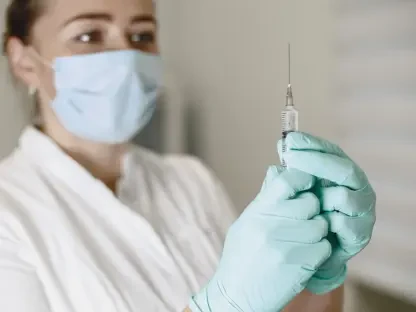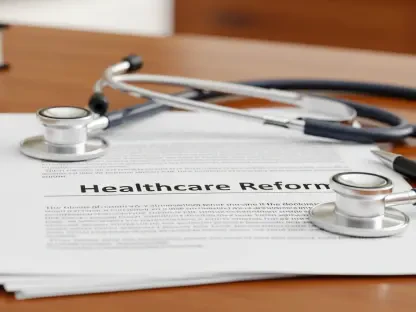Iowa Governor Kim Reynolds has laid out her ambitious 2025 legislative agenda, placing a strong emphasis on healthcare reforms and workforce development. In her recent Condition of the State Address, Reynolds highlighted the urgent need to expand both rural and maternal healthcare services, address the widespread shortage of medical professionals, and enhance medical residency programs through strategic partnerships. These proposals are aimed at dramatically improving healthcare access and outcomes across the state, particularly in underserved rural areas where the shortage of medical services is most keenly felt.
Addressing the Physician Shortage
Governor Reynolds began by addressing the national and statewide physician shortage, a problem that has severe implications for healthcare access and quality in Iowa. The state currently ranks 44th in the United States for its physician-to-patient ratio, indicating a critical deficiency in medical professionals. Despite Iowa’s high rankings in terms of healthcare quality and cost-efficiency, there remains a significant need for a diverse range of medical practitioners to adequately serve the state’s population.
The situation is poised to worsen, with the Association of American Medical Colleges projecting the national physician shortage could reach up to 86,000 by the year 2036. To counter this alarming trend, Reynolds proposed several critical initiatives, including expanding medical residencies and forging new partnerships with teaching hospitals. Additionally, she advocated for an increase in student loan repayment programs specifically designed to attract and retain medical professionals in Iowa’s rural regions. One key highlight of her address was an ambitious plan to boost funding for student loan repayment from $4.2 million to $10 million. This funding would be made available to those committing to practice in rural Iowa for a period of five years, effectively incentivizing young doctors to serve in these underserved communities.
Such a considerable increase in funding is expected to provide a compelling incentive for new medical graduates to consider a career in rural healthcare. By offering significant financial relief in exchange for a commitment to serve in rural areas, Iowa hopes to bridge the gap in its physician workforce, particularly in regions where access to healthcare has traditionally been limited.
Expanding Medical Residency Programs
One of the most significant initiatives Reynolds announced involves a strategic partnership with the University of Iowa and Broadlawns Medical Center to create additional medical residency slots—115 each year. This initiative aims to produce up to 460 new physicians trained within Iowa over the next four years, thereby bolstering the state’s medical workforce substantially. Reynolds emphasized the critical importance of residency slots, noting that doctors often choose to practice in the areas where they complete their residencies. This proposal not only aims to increase the number of trained physicians in Iowa but also fosters an environment where young doctors would be more likely to stay and serve in local communities.
This initiative has garnered bipartisan support, with figures like Senate Minority Leader Janice Weiner and House Minority Leader Jennifer Konfrst expressing their approval. However, Konfrst highlighted a significant concern: the state’s stringent abortion laws might deter incoming OBGYN professionals due to restrictions in the scope of practical training they can receive. This concern underscores the complex balance that must be struck in healthcare policy, ensuring regulations support both the recruitment and retention of medical professionals across various specializations.
The expansion of medical residency programs is crucial not only for immediate workforce development but also for establishing long-term healthcare stability. By ensuring a pipeline of newly trained physicians, these efforts can provide consistent and reliable medical care in rural Iowa, ultimately leading to improved patient outcomes and a healthier population.
Improving Maternal and Rural Healthcare
In addition to addressing broad workforce concerns, Governor Reynolds specifically targeted the deficiencies in Iowa’s maternal and rural healthcare sectors. A significant issue she highlighted was that a third of Iowa’s counties are classified as maternity care deserts, lacking OB-GYNs or birthing facilities, which necessitates immediate intervention. To combat this pressing issue, Reynolds proposed over $640,000 in investments aimed at unbundling Medicaid maternal rates. This measure is intended to better reimburse hospitals and physicians based on varying pregnancy risk levels, ensuring that the financial burden does not preclude access to adequate maternal care.
Moreover, Reynolds suggested rate increases for certified nurse-midwives and the inclusion of doula services as a covered Medicaid benefit. These proposals are part of a broader strategy to enhance maternal healthcare access and outcomes, particularly in rural areas where such services are currently severely lacking. By investing in these areas and expanding the range of services covered by Medicaid, Reynolds aims to create an environment where expecting mothers in rural areas receive the care they need.
Despite these forward-thinking measures, Iowa’s recent history of hospital closures—particularly in maternity units—remains a significant challenge. Senate Minority Leader Janice Weiner highlighted the closure of labor and delivery services at Newton Clinic, affecting Jasper County’s 32,000 residents. This incident is part of a troubling trend: a 2022 report from the Iowa Department of Public Health noted that 41 hospitals in Iowa have closed their labor and delivery services since 2000. This reduction has brought the number of counties with obstetric services down from 77 to 46, exacerbating the existing healthcare deserts in rural areas.
Addressing Hospital Closures
The trend of hospital closures in Iowa, particularly affecting labor and delivery services, has intensified the challenges faced by rural communities. The closure of Newton Clinic’s labor and delivery unit, impacting Jasper County’s 32,000 residents, is a stark reminder of these ongoing struggles. A 2022 report from the Iowa Department of Public Health indicated that since 2000, 41 hospitals in Iowa have closed their labor and delivery services, reducing the number of counties with obstetric services from 77 to just 46. This troubling development has left a significant portion of the state’s rural population without adequate maternal healthcare resources.
Senate Minority Leader Weiner emphasized the need for policies that not only offer financial incentives but also create a supportive environment for healthcare professionals to thrive in rural communities. This includes fostering local ties and ensuring that professionals who are trained in urban areas feel both welcomed and encouraged to practice in rural settings. By creating a more appealing professional landscape, Iowa can work towards reversing the trend of hospital closures and ensuring that more residents have access to essential healthcare services.
Additionally, these closures underscore the importance of Reynolds’ proposed measures for improving maternal and rural healthcare. By investing in Medicaid rate adjustments, increasing support for nurse-midwives, and including doula services, the governor aims to stabilize and even reopen critical healthcare facilities in some of these underserved regions. These steps could be key to reversing the trend of closures and ensuring that every part of Iowa has access to high-quality maternity care.
Tackling Rising Cancer Rates
Governor Reynolds also turned her attention to another pressing healthcare issue: the rising cancer rates among Iowans. She highlighted personal experiences, including her own family’s battle with cancer and that of Senate Majority Leader Jack Whitver, to underscore the human impact of this growing concern. Data revealed that Iowa has the second-highest cancer incidence rate in the United States, and this rate is increasing faster than in any other state.
A report from the University of Iowa’s College of Public Health linked the state’s high rates of binge drinking and alcohol-related cancers to these alarming statistics. Iowa leads the Midwest in alcohol-related cancer rates, with high instances of binge drinking contributing significantly to the overall cancer burden in the state.
In response to these troubling trends, Reynolds announced a collaboration between Iowa Health and Human Services and the University of Iowa aimed at confronting the root causes of this cancer surge. A dedicated team of epidemiologists will research the behavioral, genetic, and environmental factors influencing binge drinking and its cancer-related consequences. To support this crucial research initiative, Reynolds requested $1 million from the state legislature. House Majority Leader Pat Grassley voiced cautious support for the proposal, emphasizing the necessity of understanding the specifics of the partnership and how the funds will be allocated.
Broader Healthcare System Reforms
Iowa Governor Kim Reynolds has unveiled her bold 2025 legislative agenda, strongly focusing on healthcare reforms and workforce development. During her recent Condition of the State Address, Reynolds underscored the critical need to expand rural and maternal healthcare services, tackle the extensive shortage of medical professionals, and improve medical residency programs through strategic partnerships. These initiatives aim to significantly enhance healthcare access and outcomes throughout Iowa, especially in underserved rural regions where the lack of medical services is most acutely felt.
To address these issues, Governor Reynolds intends to implement a series of measures that include increasing funding for rural healthcare facilities, offering incentives to attract medical professionals to underserved areas, and creating more opportunities for medical students to gain experience in rural healthcare settings. Additionally, Reynolds plans to collaborate with educational institutions and healthcare organizations to develop innovative programs that will ensure a steady pipeline of well-trained medical professionals.
This forward-thinking agenda is designed to not only enhance the quality of healthcare in Iowa but also to stimulate local economies by providing more job opportunities in the healthcare sector. By focusing on these key areas, Governor Reynolds hopes to create a more robust and resilient healthcare system that can serve all Iowans more effectively.









